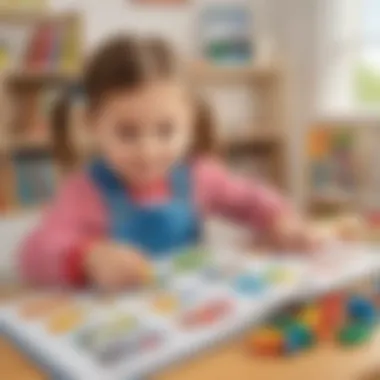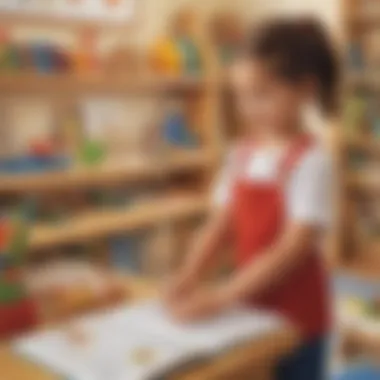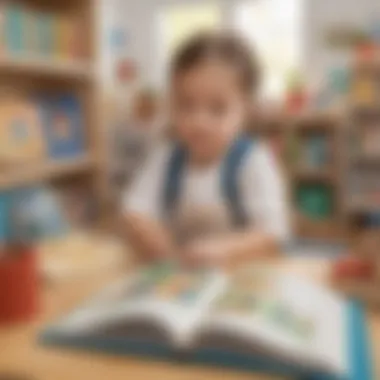Unlocking the Power of Pre-Kindergarten Learning Resources for Early Childhood Development


Creative Activities
When it comes to pre-kindergarten learning materials, incorporating creative activities is key to engaging young minds. By providing craft ideas that are easy for children to replicate, we stimulate their imagination and motor skills. Step-by-step guides accompany each activity, ensuring clarity and enabling children to follow along independently. These activities not only foster creativity but also have significant educational value. Through hands-on tasks like crafting, children develop fine motor skills, learn to follow instructions, and enhance their focus and attention span.
Fun Quizzes
Diving into the realm of fun quizzes, we explore how they complement pre-kindergarten learning materials. The quiz topics range from basic shapes and colors to simple math problems and introductory science concepts. Utilizing various question types such as multiple-choice, true or false, and matching activities, these quizzes effectively engage children and encourage active participation. By reinforcing knowledge through interactive quizzes, children reinforce learning outcomes while enjoying the process. It's a dynamic way to make education enjoyable and impactful.
Fact-Based Articles
Transitioning to fact-based articles, we uncover the extensive topics covered in this section. From animals and nature to basic science principles and social concepts, these articles offer a diverse range of information to young learners. The content is presented in an engaging and easy-to-understand manner, using visuals and simple language to convey complex ideas effectively. Additionally, we provide additional resources like links to related articles and external material for further exploration, encouraging continuous learning and curiosity in children.
Introduction
In the journey of early childhood education, the significance of pre-kindergarten learning materials cannot be understated. These resources serve as the building blocks for a child's educational development, laying a sturdy foundation for future learning endeavors. Through a careful selection of interactive tools and hands-on activities, educators and parents can shape a child's cognitive abilities and creativity from a young age. This article sets out to explore the pivotal role that learning materials play in the formative years of a child's educational journey, emphasizing their impact on holistic development and cognitive growth.
Understanding Pre-Kindergarten Learning
Benefits of Early Childhood Education
Early childhood education offers a multitude of advantages that directly impact a child's cognitive, social, and emotional growth. One of the key benefits is the stimulation of brain development during the critical early years. This stimulation sets the stage for improved cognitive functions, problem-solving skills, and language development. The interactive nature of early childhood education fosters a love for learning, creating a positive attitude towards education from a young age. However, it is essential to note that individual responses may vary, and some children may require different approaches to benefit optimally from early childhood education.
Importance of Holistic Development
Holistic development focuses on nurturing a child's overall well-being, including cognitive, emotional, and social aspects. It recognizes the interconnectedness of various skills and qualities in a child's development process. By emphasizing holistic development in pre-kindergarten learning, educators can ensure that children grow not only academically but also emotionally and socially. This approach helps in shaping well-rounded individuals who are equipped to face challenges confidently and interact effectively with their surroundings. While holistic development is crucial, it is essential to balance it with academic learning to provide children with a comprehensive educational experience.
Role of Learning Materials
Enhancing Cognitive Skills


Learning materials designed to enhance cognitive skills focus on developing a child's ability to think, reason, and solve problems. These materials often include puzzles, logic games, and activities that challenge children's strategic thinking and decision-making processes. By engaging with such materials, children can improve their memory, attention span, and critical thinking skills. The unique feature of cognitive skill-enhancing materials lies in their ability to promote intellectual growth while keeping children entertained and engaged. However, it is important to ensure that these materials align with the child's developmental stage to maximize their effectiveness.
Fostering Creativity
Creativity is a fundamental skill that allows children to express themselves, think innovatively, and approach problems with a fresh perspective. Learning materials focused on fostering creativity encourage children to explore their imagination through art, design, and imaginative play. These materials help in nurturing a child's self-expression, confidence, and originality. The unique feature of creativity-enhancing materials is their ability to instill a sense of curiosity and exploration in children, inspiring them to think creatively and outside the box. Nevertheless, it is vital to provide a balance between structured creative activities and free-form expressive play to support a child's creative development effectively.
Types of Pre-Kindergarten Learning Materials
In the realm of pre-kindergarten education, the selection of learning materials holds immense significance. These materials, including interactive tools and hands-on activities, serve as the building blocks for a child's developmental journey. By engaging young minds through a variety of resources, educators can enhance cognitive skills, foster creativity, and promote holistic development in children. Each type of learning material plays a crucial role in offering diverse learning experiences that cater to the individual needs and interests of young learners.
Interactive Tools
Interactive tools such as educational apps and digital learning games are instrumental in modern pre-kindergarten education. Educational apps provide an immersive digital learning experience that combines educational content with interactive elements. These apps can offer personalized learning experiences, adapt to individual progress, and provide immediate feedback, making them a popular choice among educators and parents. Meanwhile, digital learning games utilize gamification to engage children in learning activities, making the educational process enjoyable and engaging for young learners. The interactive nature of these tools not only captures children's attention but also enhances their cognitive skills and critical thinking abilities.
- Educational Apps: Educational apps are designed to stimulate children's curiosity and facilitate their learning process. Offering a wide range of educational content, these apps cover various subjects and skills, providing a comprehensive learning experience for children. The adaptability and interactivity of educational apps make them a beneficial choice for pre-kindergarten education, allowing children to explore and learn at their own pace. However, it is essential to monitor screen time and ensure a balanced approach to technology usage in early childhood education.
- Digital Learning Games: Digital learning games make learning fun and engaging for young children. Through interactive gameplay and challenges, these games encourage children to develop problem-solving skills, enhance hand-eye coordination, and improve spatial awareness. The gamified approach to learning captivates children's interest and motivates them to actively participate in educational activities. While digital learning games can be a valuable tool for pre-kindergarten education, it is important to balance screen time with other offline learning experiences.
Hands-On Activities
Hands-on activities, such as art and craft supplies and manipulatives, offer tangible learning experiences that stimulate creativity and fine motor skills in young children. Art and craft supplies provide children with opportunities to express themselves creatively, explore different materials, and engage in sensory experiences. These supplies not only foster artistic development but also promote cognitive skills such as decision-making and problem-solving. On the other hand, manipulatives, such as building blocks and puzzles, offer hands-on learning opportunities that enhance spatial awareness, mathematical thinking, and fine motor skills. By manipulating physical objects, children can develop a deeper understanding of concepts and engage in kinesthetic learning experiences.
- Art and Craft Supplies: Art and craft supplies are essential tools for fostering creativity and self-expression in young children. From painting and drawing to sculpting and collage, these materials allow children to unleash their imagination and create unique works of art. The tactile nature of art and craft supplies not only enhances children's fine motor skills but also promotes sensory exploration and emotional expression. While art and craft activities are beneficial for pre-kindergarten education, it is important to provide a balanced range of activities that cater to different interests and learning styles.
- Manipulatives: Manipulatives are versatile learning tools that offer hands-on experiences in mathematics, science, and problem-solving. By manipulating objects such as counting bears, pattern blocks, and shape sorters, children can concretely explore mathematical concepts, develop spatial reasoning skills, and enhance their logical thinking abilities. The tactile sensation and physical engagement provided by manipulatives make learning more interactive and engaging for young children. However, educators should ensure that manipulatives are age-appropriate, durable, and safe for children to use in educational settings.
Choosing the Right Learning Materials
In the pursuit of understanding the essence of pre-kindergarten learning materials, it becomes evident that the selection of the appropriate educational resources holds paramount importance. The foundational steps laid in early childhood education significantly impact a child's developmental trajectory. Choosing the right learning materials involves a meticulous evaluation process, where the specific elements, benefits, and considerations of each material play a crucial role in shaping the learning experience. Tailoring educational resources to meet the unique needs of each child fosters an environment conducive to holistic growth and cognitive development.
Engagement and Relevance
Alignment with Curriculum
addressing the essential component of alignment with the curriculum, it is imperative to underscore how this aspect contributes to the overarching goal of optimizing the learning experience for pre-kindergarten children. Ensuring that learning materials align seamlessly with the prescribed curriculum aids in reinforcing key concepts and skills targeted for educational attainment. The compatibility of educational resources with the curriculum enhances cohesiveness in lesson planning and delivery, maximizing the efficacy of teaching methodologies. This harmonious alignment not only facilitates consistency in educational objectives but also promotes a structured approach to learning, augmenting the educational journey of young learners.


Interactive Features
The integration of interactive features within learning materials stands as a pivotal element in enriching the pre-kindergarten educational landscape. Interactive features bring forth a dynamic dimension to learning, engaging young minds through immersive and participatory activities. By incorporating interactive elements such as touch-responsive interfaces or voice-guided prompts, educational resources cater to the interactive nature of early childhood learning. The allure of interactive features lies in their ability to captivate young learners' attention, fostering active participation and enhancing knowledge retention. Despite the evident benefits of interactive features, careful consideration must be given to balancing screen time and hands-on activities to maintain a holistic learning experience for children._
Safety and Durability
Non-Toxic Materials
Examining the significance of non-toxic materials underscores their pivotal contribution to ensuring a safe and conducive learning environment for young children. Opting for non-toxic materials in learning resources mitigates potential health risks associated with toxic exposure, safeguarding the well-being of children during their formative years. The widespread adoption of non-toxic materials reflects a commitment to prioritizing children's safety and health in educational settings. The inherent safety of non-toxic materials not only aligns with regulatory standards but also promotes peace of mind among parents and educators, consolidating a culture of caution and protection in early childhood education._
Longevity of Use
Evaluating the longevity of use of learning materials reveals its indelible impact on the sustainability and efficacy of educational resources. Materials possessing longevity of use are characterized by their durability and resilience to wear and tear, ensuring prolonged utility over an extended period. The enduring nature of such materials transcends short-term usage limitations, enabling educators to recalibrate lesson plans and learning activities without recurrent replacement requirements. Despite the apparent advantages of extended usability, careful maintenance and periodic assessments are imperative to uphold the quality and functionality of materials, enhancing their longevity and optimizing educational outcomes for pre-kindergarten children.
Incorporating Learning Materials in Pre-Kindergarten Settings
In the realm of pre-kindergarten education, incorporating learning materials within the classroom setting is a pivotal element essential for fostering comprehensive learning experiences. By strategically integrating a variety of educational resources, educators aim to create an enriching environment that promotes cognitive development, creativity, and engagement among young learners. The careful selection and placement of these materials can significantly impact a child's academic and social progress, making it a fundamental consideration for early childhood educators and caregivers. Through thoughtful curation and utilization, learning materials can act as catalysts for exploration, discovery, and skill development in pre-kindergarten settings.
Classroom Environment
Learning Centers
Learning centers within pre-kindergarten classrooms serve as designated areas where children engage in focused activities that cater to specific learning objectives and developmental goals. The design of learning centers is structured to offer hands-on experiences, promote independent learning, and encourage collaboration among students. These centers are equipped with a range of educational materials and resources tailored to different subjects or skills, allowing children to explore diverse interests and engage in experiential learning. The intentional organization of these spaces facilitates differentiated instruction, enabling educators to address individual learning needs effectively.
Visual Displays
Visual displays play a crucial role in creating an immersive and stimulating learning environment for young learners. By showcasing student work, educational content, and informative visuals, visual displays enhance the aesthetics of the classroom while serving as valuable educational tools. Visual aids not only reinforce learning concepts but also spark curiosity and engagement among children. Well-designed displays can effectively communicate information, stimulate critical thinking, and inspire creativity in students. However, it is essential to ensure that visual displays are age-appropriate, culturally relevant, and aligned with learning objectives to maximize their educational impact.
Teacher Facilitation
Guided Exploration


Guided exploration involves educators providing structured opportunities for students to investigate and discover learning concepts in a supportive environment. By offering guidance, feedback, and prompting questions, teachers scaffold the learning process and facilitate deeper understanding. This approach encourages critical thinking, problem-solving skills, and metacognitive development in young learners. Through guided exploration, teachers cultivate a sense of curiosity, autonomy, and self-regulation among students, nurturing a lifelong love for learning.
Encouraging Inquiry
Encouraging inquiry in pre-kindergarten settings entails fostering a culture of questioning, exploration, and investigation. Teachers play a vital role in stimulating curiosity, promoting inquiry-based learning, and encouraging children to seek answers independently. By posing thought-provoking questions, posing open-ended challenges, and provoking curiosity, educators inspire students to delve into topics, experiment with ideas, and construct their understanding. Encouraging inquiry empowers children to become active, engaged learners, capable of exploring the world around them with enthusiasm and a thirst for knowledge.
Evaluating the Impact of Learning Materials
In this section, we delve into the critical aspect of evaluating the impact that learning materials have on pre-kindergarten education. Assessing the effectiveness of these resources is crucial in determining their value in shaping young minds. By evaluating the impact of learning materials, we can ensure that they align with educational goals and contribute meaningfully to a child's development journey.
Assessment Strategies
Observation
Observation plays a pivotal role in evaluating the impact of learning materials. By keenly observing how children interact with educational resources, educators can gather valuable insights into their engagement, comprehension, and skill acquisition. The key characteristic of observation lies in its direct and unobtrusive nature, allowing for authentic assessment of children's learning experiences. Observing students in action provides a unique perspective on their individual learning styles and preferences, facilitating tailored instructional approaches.
In this article, observation emerges as a beneficial choice due to its ability to capture real-time data on children's responses to learning materials. The unique feature of observation lies in its capacity to reveal nuanced details that may not surface through traditional assessment methods. However, challenges such as observer bias and limited observation windows exist. Despite these considerations, observation stands as a valuable tool in evaluating the impact of learning materials in pre-kindergarten settings.
Feedback Mechanisms
Another vital aspect of evaluating the impact of learning materials involves leveraging feedback mechanisms to gather evaluative data. By soliciting feedback from students, parents, and fellow educators, we can gain comprehensive insights into the efficacy and relevance of educational resources. Feedback mechanisms serve as a direct line of communication, inviting stakeholders to share their perspectives on the benefits and shortcomings of learning materials.
The key characteristic of feedback mechanisms is their capacity to foster continuous improvement and refinement of educational practices. This constant loop of feedback enables educators to tailor learning materials to meet evolving needs and preferences. While feedback mechanisms provide valuable information, challenges such as ensuring feedback authenticity and addressing varying opinions may arise. Despite these complexities, feedback mechanisms play a crucial role in evaluating the impact of learning materials, enhancing educational outcomes and refining instruction.
Measuring Learning Outcomes
Skill Development
Within the realm of evaluating learning materials, assessing skill development stands as a fundamental aspect. Understanding how educational resources contribute to the acquisition and enhancement of skills is essential in gauging their impact on children's overall development. Skill development encompasses a wide spectrum of abilities, ranging from motor skills to critical thinking, all of which play a role in shaping a child's cognitive growth.
The key characteristic of skill development assessment is its focus on measuring tangible progress and mastery in specific areas. By tracking skill development, educators can identify strengths and weaknesses, tailor instructional strategies, and design targeted interventions. The unique feature of skill development assessment lies in its ability to provide concrete data on individual progress, informing personalized learning pathways.
Knowledge Acquisition
Another crucial element in measuring learning outcomes is evaluating knowledge acquisition through educational materials. Assessing how children absorb, retain, and apply knowledge from learning resources is paramount in gauging their educational efficacy. Knowledge acquisition encompasses comprehension, retention, and transfer of information, reflecting the depth and breadth of a child's learning experience.
The key characteristic of knowledge acquisition assessment lies in its emphasis on evaluating cognitive growth and content mastery. By examining how children internalize and utilize information from educational materials, educators can tailor instruction to enhance conceptual understanding and application skills. The unique feature of knowledge acquisition assessment lies in its capacity to inform curriculum adaptation and instructional scaffolding, ensuring optimal learning outcomes for all students.







